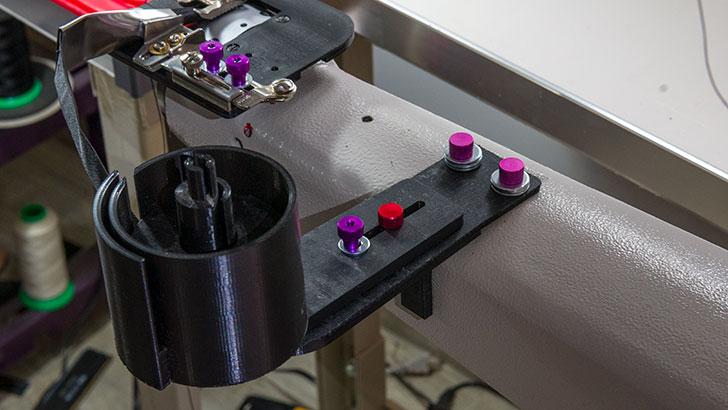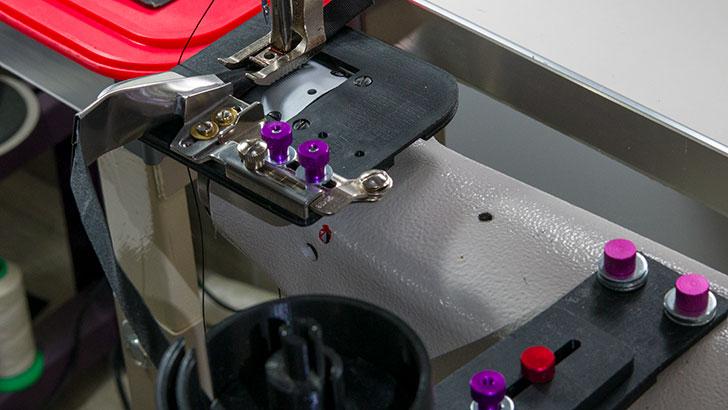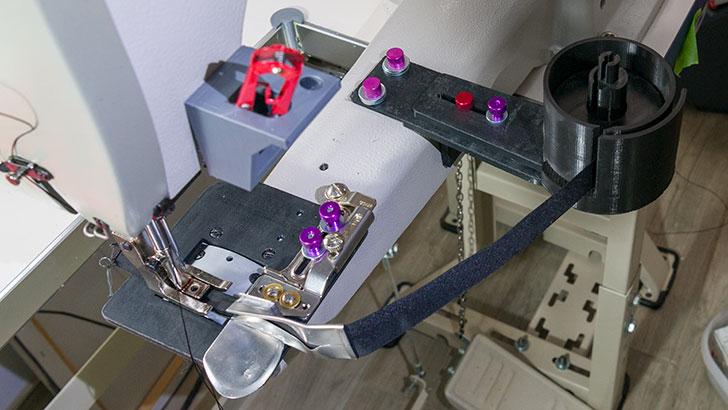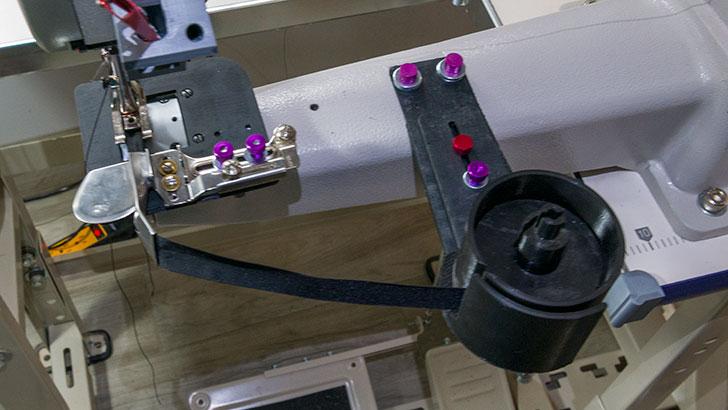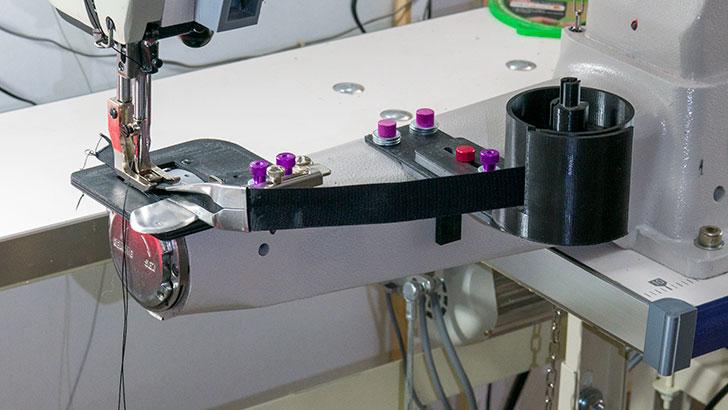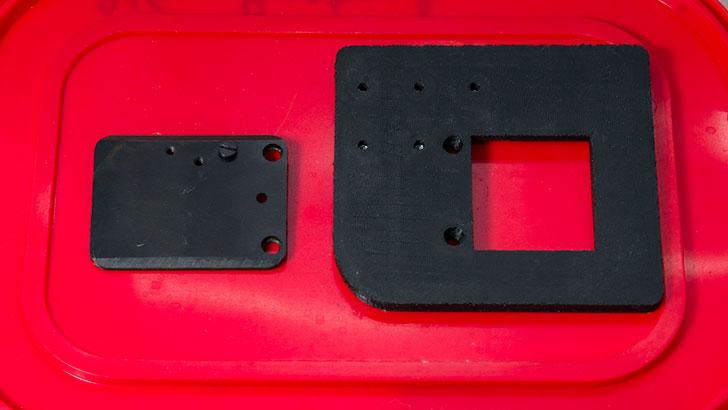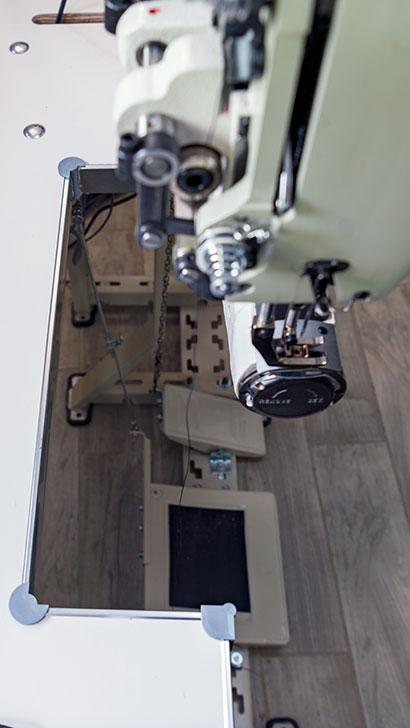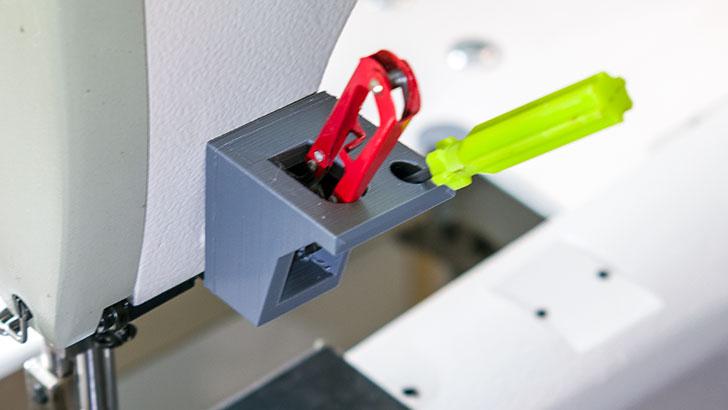
kgg
Contributing Member-
Posts
3,305 -
Joined
-
Last visited
Content Type
Profiles
Forums
Events
Blogs
Gallery
Everything posted by kgg
-
@Jeff96 I would either get your old PFAFF 138 back or buy a used one rather then going with the Zoyer machine. Doing a quick search on Kijiji in Ontario shows two used ones available ( https://www.kijiji.ca/v-other-home-appliance/mississauga-peel-region/used-pfaff-industrial-sewing-machine/1668649324 ) for $200 Cad and ( https://www.kijiji.ca/v-hobbies-craft/gatineau/pfaff-138-6-sewing-machine/1649347146 ) for $450. Just on the surface the $200 one seems to be in better shape. The problem with the PFAFF's in general is parts availability and cost of replacement parts.
-
Thank you. I usually have to buy 8 or 10 of the 1kg (2.2 lb) spools at a time to feed the addiction. I'm glad I was of some help. The hardest part was getting the underside of my slide plate so it was supported by the needle plate also and not just by the two slide plate bolts. My old micrometer got a workout. The above photo with the slide plates on the red background is of my original prototype and not the actual one on the 441. That one was just a proof of concept so I really didn't care too much about squish (gives rough edges) or that the filament wasn't properly dehydrated (gives inconsistent melting / welding of layers) or that the nuts weren't properly seated. I also forgot to take a photo of the underside of the original slide plate and how it compares to my slide plates underside.
-
I do a fair bit of binding and don't like using the expensive right angle binding attachments unless I have too. I like being able to take the relatively inexpensive inline binding folders and be able to use them on all my machines whether flatbed or cylinder arm. To that end with the machine having a small sized slide plate it was proving difficult. My solution was make two new slide plates and incorporate a small work surface in them. The first one a mini slide plate is for doing mostly binding / belts. A larger one gives a work surface of about 4.5 inches x 7 inches left of the needle and would be more suited to wallets / holster type work. I also incorporated a binding "cup" that is slung off the arm. The cup can hold about 25 ft. of binding material of 2 inch wide tape on its bobbin for those small jobs or act as an adjustable tension guide between the binding tape platter and the folder. Please note the bolts are just temporary as I'm waiting for proper length bolts to arrive. The photo's show a 1" raw edge folder with a swing away attachment. The last photo shows the difference of the original slide plate, on the left and my small slide plate. All comments are always appreciated. kgg
-
I don't hand stitch so I can't help with sizes but if you search for "stitching needles" or "harness needles" you should come up with a few options from places like Tandy and Weaver ( https://www.weaverleathersupply.com/collections/needles ). kgg
-
Techsew 2700 - Stitch length adjuster issues.
kgg replied to SpruceMoose's topic in Leather Sewing Machines
The Juki LS- 341is a different machine. The 2700 would be closer to a PFAFF 335 then the Juki LS-341 while their Techsew 2750 is a clone of the Juki LS-341. kgg -
Techsew 2700 - Stitch length adjuster issues.
kgg replied to SpruceMoose's topic in Leather Sewing Machines
Since you probably don't have a manual I think the Techsew 2700 is similar to the Seiko cw8b , Cowboy cb227r and the Consew 227r so here is a pdf of the manual that maybe of some use to you. kgg CB227R_Oper.Manual_print_pages_3-13.pdf -
Very nicely done. I do like the color adds a bit of class. kgg
-
Very nicely done. kgg
-
Larger Handwheel With Smaller Pulley, For Juki Lu-563 / Consew 226
kgg replied to Ken B's topic in Leather Sewing Machines
Yes increasing the size of the existing hand-wheel pulley will decrease your rpm's at the hand-wheel but.... example. existing hand-wheel pulley is 3 1/2 " (89mm) and the size of the motor pulley is 3"(75mm) the motor speed is set for a max speed of 500rpm then the hand-wheel pulley rpm will be 421. i) changing the motor pulley to a 45mm and changing noting else the hand-wheel pulley rpm's drops to 252 ii) changing the hand-wheel pulley to 6" (152mm) with the new 45mm motor pulley will drop the hand-wheel pulley rpm's down to 148 But just to change the hand-wheel size alone from 3 1/2 to 6" without changing the motor pulley size the hand-wheel rpms drops to 246 which you can get by just changing the size of the motor pulley. To get a real change you would have change the hand-wheel pulley to something above 10" (254mm) and you that may cause other problems. I think you would be much better off using a speed reducer pulley (6" large pulley coupled to a 2" small pulley) and changing the motor pulley to 45mm then the hand-wheel speed would drop to 74 with a lot less work. If you already have a speed reducer then going to a 6" hand-wheel pulley would drop the hand-wheel rpm's down to 43. How slow do you want to go and what set the lowest set point on your motor?? kgg -
Nice job. kgg
-
I built a small footprint table for a LSZ-1 clone a little while back. I am sure you could come up with something similar that would fit your machine. For the K-legs checkout an industrial sewing machine repair shop. In my area they usually have plenty of used K legs on hand at a reasonable cost. kgg
-
That's understandable. kgg
-
What was their asking price??? If it was cheap enough you could buy it for the treadle stand for future use on a later model like a Singer 29k-70/71/72 or a clone as the base mounting bolt hole spacing are the same. kgg
-
I do like the Singer machines but I would pass on a 29-4 as they are even older then the 29k-4 myself. I think the bushing and rack's aren't being made anymore for the 29-4. Keep in mind that the machine is going to be 100+ years old and the new patcher clone machines are being based around the 29k-70/71/72 models. In Ontario the price of the Singer 29K's in general have skyrocketed to and over $1000 CAD ($750 USD) whereas you can get a new clone for under $700 CAD off Amazon however the quality maybe questionable but parts would be cheap and readily available. Just my thoughts, kgg
-
Measurements of speed reducer box needed
kgg replied to Metalhorseman's topic in Leather Sewing Machines
A couple of photo's of how your machine is setup on your table would help. If your short on space a suspended reducer pulley maybe a better solution then a box style speed reducer. With the suspended style you can install them either on top or underneath the table top. -
My calculation for the top speed of the hand-wheel pulley should come in at 156 rpm using a 160 mm hand-wheel pulley size, a 50 mm motor pulley and with the motor speed set to the minimum speed of 500 rpm's. This particular servo motor is a 800 watt brushless 9 coil servo motor with a speed range of 500 to 5000 rpm's. So me being me I had measure the pulleys and hand-wheel to see how far off my calculations were. A) The constants: i) The hand-wheel pulley measured out to be 159mm. ii) The small pulley at the motor measured out at 49mm. iii) No speed reducer is installed. The results with 500 rpm's showing on the controller screen i) with the foot pedal fully depressed the rpm's with my digital tachometer showed 154.5 rpm's ii) with the foot pedal feathered to get the minimum hand-wheel pulley speed the digital tachometer showed a low rpm reading of 61 rpm's If I were to install a speed reducer (100 large pulley with a 50 mm pulley) I figure I could drop the max speed down to 77 rpms and the feathered speed down to around 24 rpms. kgg
-
What machine do you have, name and model number? kgg
-
My understanding is the Cobra Class 26 is a clone of the old Juki LS-341 so if you want a good manual download the manual for the Juki LS-341, Engineers manual. The Juki appears to rate their machines max thread size to the machines capabilities at max sewing capacity not by what size of thread can be stuffed through the max size needle. Juki LS-341 will take V207 thread yet the machine is only rated for V138 thread. You may have success with V207 thread for the top and bobbin thread in thinner material or V207 top thread with V138 bobbin thread in thicker items. kgg Juki_LS-341N_Engineers_Manual.pdf
-
You never mention how thick the items are that you are trying to sew. The 100/16 needle is really the bottom end for sewing with V69 in thin items or for V46 in thicker items. In thicker / tougher items move up to a size 19 or 20 needle. The problems to me sounds like the needle is being bent / deflected and with such a thin needle, size 16, it is going to be prone to breaking even with a tuned machine. kgg
-
Thank you. Dang I missed that one. kgg
-
Thank you. Those parts will fit any of the 441 class machines but hopefully make life a little more convenient. The cross brace from the right support leg across to the leg support leg is bend around the vertical support which should help. In this case I don't think drooping is going to be a problem as the downward weight of the machine is slightly off centered towards the front of the machines base. That should help to offset / reduce the amount of forward and downward torquing of the machine. When I remove the top horizontal section of the left support leg to remove about 6" the machine showed no signs of wanting to tip forward and downward. The top horizontal cross braces for all the legs were also lag bolted into the bottom of the table with four 1/4" x 1" lag bolts to the bottom side of the 1 1/2" table top. The top horizontal cross brace of the middle leg extends back to almost touching the mounting frame for the servo motor. kgg
-
Here is what has been done and I will be adding other accessories in the future for binding, etc. All comments are always appreciated. From what it looked like in the beginning to present. Note the drive belt beauty cover and needle positioner were placed just for the photo's and have been delegated to the darkest corner of the spare parts bin. 1) The table top cutout has been completed. i) The raw edge of the table top section that was cutout was trimmed off with metal edging, photo called Cutout.jpg, and Cutout 4.jpg . ii) The sharp metal corners have 3D printed trims to help soften the sharp 90 degree corner, photo called Cutout.jpg . iii) Two holes were drilled into the right side of the table top and two 3D printed thread guides installed to allow the top and bobbin spools of thread to be threaded through the table top. The reason for this was to allow for more usable space on the table top for other accessories and to allow for better thread relaxation / uncoiling, photo's Thread Spools.jpg and FrontALT.jpg. 2) The table metal support frame modifications are completed. i) The top horizontal overhang part of the left leg was cut back to the vertical support and reinstalled. I had to repaint this top section with the best match of paint I could find called "Sand" color, Front.jpg . This was my fault of allowing the cutoff blade to strike the vertical part of the support and grind into the paint / metal. When the top of the left leg was removed from the table so the machine was only supported by the center and right leg there was no problems of the machine, being nose heavy, wanting to tip forward. ii) I added an additional horizontal cross brace from the left leg to the right leg, FrontALT.jpg . This wasn't necessary but I had a 2" wide piece of 1/8" metal kicking around and it is cheap insurance. iii) The top and bobbin thread spool holder was installed on the right leg cross brace to allow for threading from underneath the table, Thread Spool.jpg and Thread Spool 2.jpg . 3) Machine convenience accessories have been 3D printed and installed on the machine with no drilling or tapping of holes in the machine. i) Snips and screwdriver holder installed to the front of the machine putting both in easy reach, Snips.jpg . ii) Bobbin and needle storage insert installed inside the wax pot to make better use of what would be a waste of space for me, Wax Pot.jpg . iii) Top and bobbin thread pin guide support installed. This support allows for a straight line from the top thread tensioner to the guide on the thread spool support. This also has a double bobbin holder incorporated to allow for a quick convenient place to store bobbins, Thread Pin.jpg .and Thread Pin 1.jpg .
-
The answer is yes. Some of the 29k's came with a domestic small foot pedal operated motor which cost about $30- 40 CAD but the mounting hole is in the casing on some models. I owned a 29K-71 which came from Landis and they had installed a geared domestic motor on it before being sold to the original owner. Speed can be an issue with the 29K's and clones as they are not really rated for anything over 500 rpm. You can see the motor on the rear side of the Singer 29K-71 in video https://odysee.com/@SingerSewing:0/singer:a The main purpose of that video is to demonstrate how effortless they should be able to be turned over by hand without anything under the presser foot. Another video with just a straight domestic motor installed on a 29k https://www.youtube.com/watch?v=qICJV7j56Gs Also here is another one be it of poor quality with a servo motor installed. https://www.youtube.com/watch?v=vMfzIcJ-spY The main question is are you trying to get torque for punching poor or just convenience of being able to use both hands? If I'm not mistaken the Eagle 550 is a 6 or 9 coil brushless motor. I think the motor has 6 coils but the sudden jump in my opinion is do to the motor having less coils. The 9 and 12 coil brushless don't seem to have this problem or not as noticeable. More internal motor coils means higher low speed torque with smoother speed control. Adding a speed reduce can really help mask the problem. kgg
-
Stay way from the cheap Chinese thread particularly in the 8 oz spool size. It can be a frustration generator. Buy a brand name sewing thread preferably one made in North America like A&E ( www.amefird.com ). Yes it will be more expensive but a quality products. Depends on what you are sewing. If the item is going to be exposed to a lot of UV rays or bleach bonded polyester would provide better protection then bonded nylon. Typically bonded polyester has a slightly lower breaking strength then bonded nylon for the same size of thread. You did mention "small holsters" the Cobra Class 26 can only handle up to V207 thread which maybe a little light for a holster. Some of the holster makers could address the best size of thread to use. kgg
-
@Handstitched, nicely done. kgg



